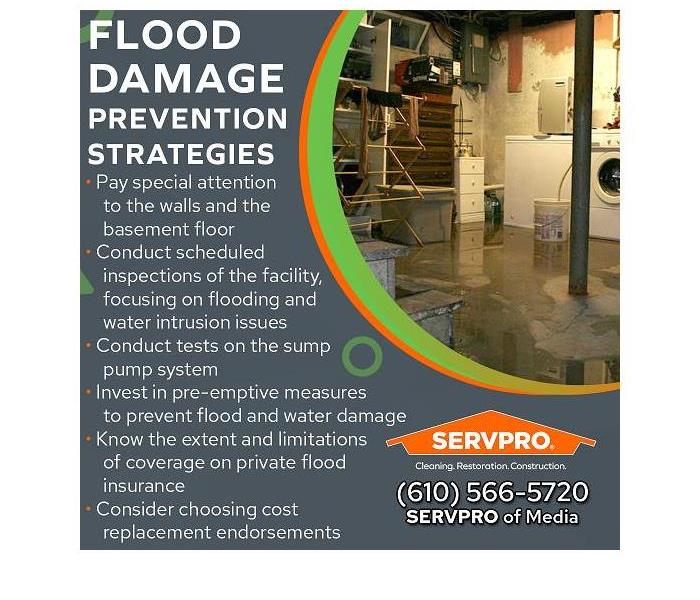How to Prevent Flood Damage from Affecting Springfield, PA, Office Buildings
5/24/2022 (Permalink)
Blog Summary: SERVPRO of Media offers tips to prevent flood damage at office complexes in Springfield, PA.
Flood restoration services are vitally important for an office complex that has suffered a storm and flood damage disaster. SERVPRO of Media, PA, understands the importance of providing a fast response and rapid cleanup and restoration so that business operations can return to normal as soon as possible. The owner of an office complex needs to embrace a two-pronged approach to address flood damage: adequate insurance coverage and effective flood damage prevention strategies.
The Importance of Sufficient Flood Damage Insurance
Commercial property damage insurance can protect an office complex from fire damage and acts of vandalism. However, inadequate flood damage coverage could spell the end of a business if severe weather causes flooding. Typical commercial property damage policies do not cover weather-related flooding. Coverage is available through the National Flood Insurance Program (NFIP).
Federal flood insurance is not without its challenges. NFIP insurance adjustors may not cover water damage resulting from roof damage caused by high winds. The NFIP policy may only cover actual cash value, which leaves the business owner liable for depreciation and any deductibles. NFIP also offers federal disaster loans. These loans must be repaid, and failure to understand the repayment terms can be financially catastrophic.
The Benefits of Commercial Property Damage Insurance
The NFIP policy should be supplemented with commercial insurance that specifically covers flood protection. The private policy should cover adverse events such as internal flooding (pipe leaks), a water intrusion (roof leak), and natural disasters (flooding in the wake of a hurricane). Though costly, the supplemental coverage saves millions of dollars in losses.
Flood Damage Prevention Strategies
Securing comprehensive insurance policies is an effective strategy to protect the property owner’s investment and mitigate flood risks. Property owners can also reduce the risk of flood damage costs by implementing several practical tips.
Tip #1: Conduct scheduled inspections of the facility, focusing on flooding and water intrusion issues.
The recommended frequency is two or three times a year. If the summer months are unusually wet, a midsummer inspection might be needed. In the event of severe weather such as a hurricane, tornado, or tropical depression, initiate an inspection with the facilities manager to check for signs of flooding or high humidity. A mold infestation could be in progress. A strong smell of mold or mildew may require a closer examination by a professional.
Tip #2: Pay special attention to the walls and the basement floor.
Look, smell, and feel for signs of a water intrusion. Residue, mold, and mildew trailing down the wall are key indicators of an issue. Puddled water or water stains on the floor signal the possibility of a leak. Listen for dripping water. Cracks in the walls or flooring may eventually progress to the point where water intrusion is likely. Fire sprinkler heads should be included in the inspection protocol. An annual inspection by a professional is advisable.
Tip #3: Conduct tests on the sump pump system.
Test not only the main sump pump but also the backup system. Clean out any debris in the drain. In some instances, a commercial dehumidifier may need to be installed. If a dehumidifier is in place, include it in the inspection. A heavy-duty dehumidifier can be expensive, but the quality is worth the price, the peace of mind, and a mold-free basement.
Tip #4: Invest in pre-emptive measures to prevent flood and water damage.
These measures include waterproof sprays, caulking, or wraps. In an older structure, the property owner would do well to consider taking on the extra expense of ordinance and law coverage in the commercial property insurance policy. This rider covers the added cost of restoring damaged property to local construction ordinances and current building codes.
Tip #5: Know the extent and limitations of coverage on private flood insurance.
A specific flood policy may not automatically cover all flood-related losses. Payment for inventory losses and structural damage are covered. The private flood policy should also cover the following items:
- Drying and dehumidification
- Replacement of the boiler if needed
- Cleaning the HVAC system, including ductwork
- Mold remediation
- Debris removal
Tip #6: Consider choosing cost replacement endorsements.
The business owner has a variety of policy endorsement options from which to choose. These endorsements offer added protection against a covered loss. Careful consideration must go into each decision.
Business income loss is an endorsement that replaces the following losses in the event of flood damage that interrupts normal business operations:
- Net profits
- Payroll
- Regular expenses
Coverage is limited to a specific time frame after the adverse event. Coverage for extra expenses is included. A business that has been severely damaged may have to vacate the premises for a time. This payout for additional expenses can be used for construction costs, rent for temporary office space, and other miscellaneous costs related to a covered event.
In the event of a flood damage disaster in an office complex or other commercial setting, trust the professionals at SERVPRO of Media. The company’s fast response and rapid cleanup enable a business to restore normal business operations as soon as possible, saving time and money. SERVPRO leverages the best equipment, advanced technology, and the latest cleaning techniques and products to complete the job in a timely and safe manner. Pre-qualify a property damage cleanup and restoration company before a disaster strikes.
For more information about flood damage restoration services in Springfield, PA, contact SERVPRO of Media by calling (610) 566-5720 or by emailing office@SERVPROmedia.com






 24/7 Emergency Service
24/7 Emergency Service
